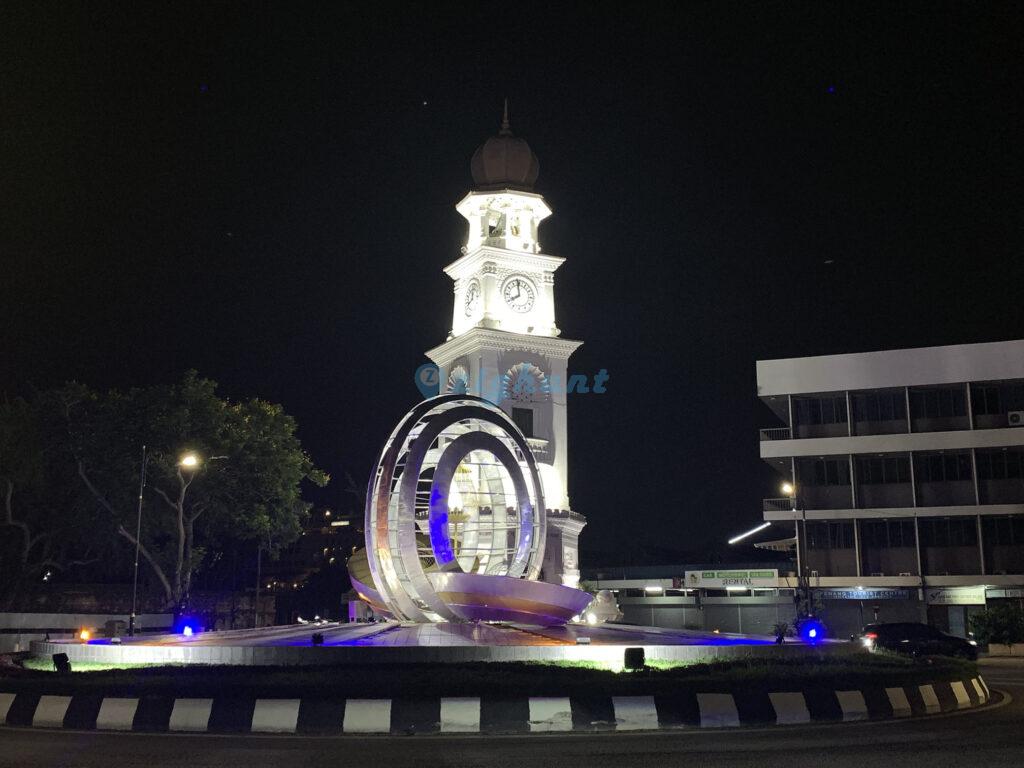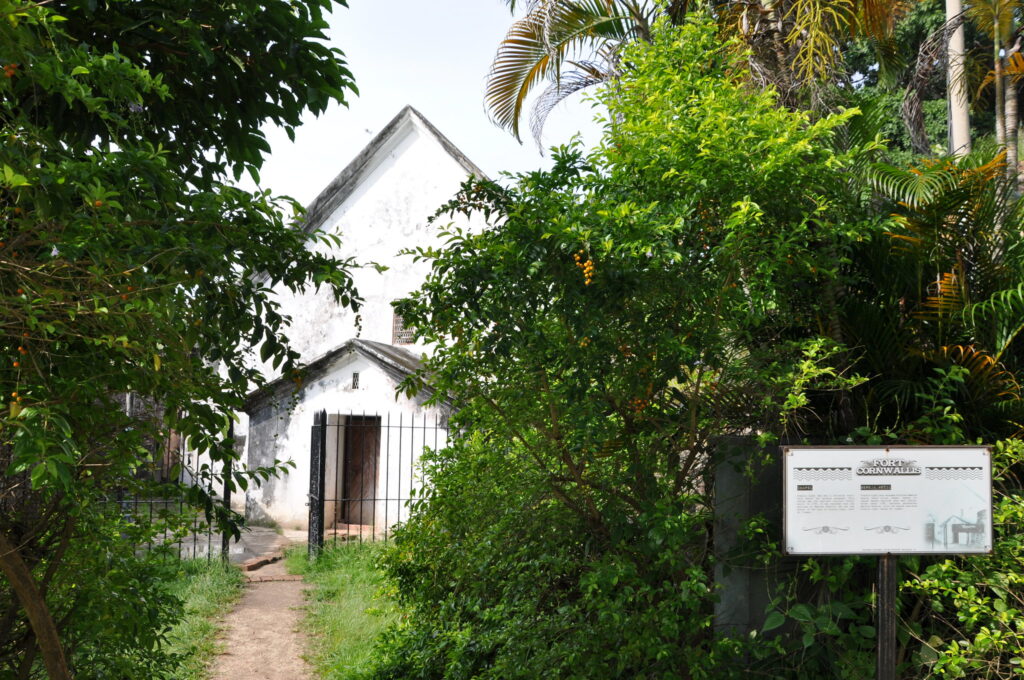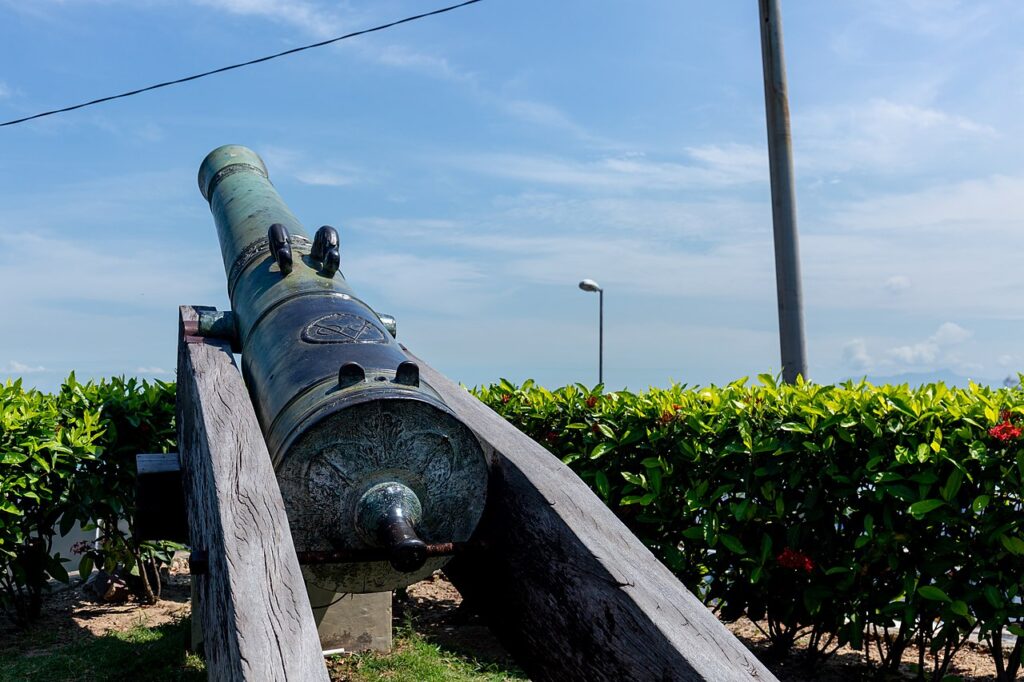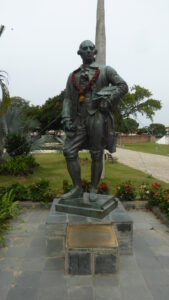Discover History and Heritage at Fort Cornwallis Penang
Fort Cornwallis is a historical landmark nestled on Penang Island, Malaysia. With its rich British colonial history and fascinating architecture, the fort offers a glimpse into the past and showcases the island’s unique heritage.
Constructed in 1786 by Sir Francis Light after the British government took control of Penang Island, Fort Cornwallis served as a strategic protector of the Penang Harbor. Initially built with palm trunks, it was reinforced with bricks over the years. Despite its significance, the fort has never been engaged in battle.
Essential Insights
- Fort Cornwallis is a captivating historical landmark on Penang Island.
- It reflects the British colonial history of Penang and offers insights into the island’s heritage.
- Constructed in 1786, the fort served as a protective stronghold for Penang Harbor.
- Despite its significance, Fort Cornwallis has never witnessed any battles.
- Visiting the fort provides a unique opportunity to explore the island’s colonial past and appreciate its historical value.
Table of Contents:
Explore Fort Cornwallis’ Architectural Treasures
Discover the Surrounding Gems of Fort Cornwallis
Learn About Captain Francis Light’s Legacy
Explore the Historical Significance of the Gunpowder Magazine
Discover the Fascinating Story of the Seri Rambai Cannon
Discover the Queen Victoria Memorial Clock Tower
Explore the Historic Chapel within Fort Cornwallis
Plan Your Visit to Fort Cornwallis Penang
Conclusion
FAQ
Explore Fort Cornwallis’ Architectural Treasures
Inside Fort Cornwallis, visitors can explore several notable structures that reflect the historical significance of the fort. These architectural treasures offer a glimpse into Penang’s past and provide a unique experience for history enthusiasts.
“The architectural treasures of Fort Cornwallis transport visitors back in time, allowing them to immerse themselves in the rich history of the region.”
Gunpowder Magazine
The Gunpowder Magazine, built in 1814, served as a vital component of the fort’s defense system. This structure was specifically designed to store gunpowder and ammunition for the cannons, ensuring the fort was well-equipped for any potential conflicts. Its strategic placement within the fort made it easily accessible for artillerymen when they needed to load the cannons.
Stockade Cell
The Stockade Cell, originally used to house artillerymen, later served as a prison within Fort Cornwallis. This structure provides a glimpse into the daily lives of the occupants and the fort’s role in maintaining order. Today, visitors can explore the Stockade Cell and imagine the life of those confined within its walls.
Chapel
The chapel within Fort Cornwallis is a significant historical landmark. Dating back to 1799, it is the first constructed chapel in Penang and played an important role as a place of worship for military personnel and civilians stationed at the fort. Inside the chapel, visitors can find exhibits that highlight the history of Penang and the notable individuals associated with the region.
Seri Rambai Cannon
One of the most prominent features of Fort Cornwallis is the Seri Rambai Cannon. Cast in 1603, this brass cannon holds significant cultural and historical value. Local folklore attributes special powers to the cannon, with beliefs that placing flowers inside the barrel can cure infertility in women. The Seri Rambai Cannon stands as a tangible link to Penang’s past and a testament to the fort’s historical importance.
| Structure | Significance |
|---|---|
| Gunpowder Magazine | Storage for gunpowder and ammunition |
| Stockade Cell | Housing for artillerymen and later used as a prison |
| Chapel | First constructed chapel in Penang, place of worship for military personnel and civilians |
| Seri Rambai Cannon | Believed to have special powers, associated with local folklore |
Discover the Surrounding Gems of Fort Cornwallis
Close to Fort Cornwallis, visitors can find other interesting attractions that add to the charm of the area.
Queen Victoria Clock Tower: Constructed in 1897, the iconic Queen Victoria Clock Tower stands as a symbol of Queen Victoria’s 60-year reign. It serves as a significant historical landmark and offers a glimpse into the colonial era.
Penang Harbor Lighthouse: Also known as the Fort Cornwallis Lighthouse, the Penang Harbor Lighthouse is a prominent landmark near the fort. It not only showcases the importance of maritime navigation but also adds to the visual appeal of the surrounding area.
Seaside Esplanade: For those looking to enjoy a leisurely walk or soak in the breathtaking views of the sea, the seaside esplanade provides the perfect setting. With a beautiful lawn leading to the City Hall, it offers a picturesque and relaxing environment for visitors.
Learn About Captain Francis Light’s Legacy
Captain Francis Light, an esteemed British explorer and trader, founded Penang in 1786. As the superintendent of the colony, he played a significant role in its establishment and development. Although there are no recorded illustrations or paintings of Light, a statue of him stands within Fort Cornwallis. Interestingly, the statue is modeled after his son William.
Light’s legacy as a fair and honorable man is remembered through his contributions to Penang’s history.
Notable Contributions
Light’s vision and strategic decision to establish Penang as a trading port have had a lasting impact on the region. He recognized the potential of Penang’s natural harbor and strategically located it along the important trading routes between India and China.
Under Light’s leadership, Penang grew from a mere outpost to a thriving trading hub. He implemented governance systems, encouraged agricultural development, and created a stable environment for trade and commerce.
Light’s fair treatment of the local population and respect for their customs and culture earned him the trust and cooperation of the Malays and Chinese in Penang. His inclusive approach laid the foundation for peaceful coexistence and multiculturalism, which remains a defining characteristic of Penang to this day.
Legacy and Commemoration
Today, people revere Captain Francis Light today as the founder of Penang and fondly remember him for his contributions to the island’s development. His legacy manifests in Penang’s flourishing economy, diverse culture, and rich heritage.
To honor Light’s memory, a statue was erected in Fort Cornwallis. Although it depicts his son William, an accomplished military officer, the statue serves as a symbol of Captain Francis Light and his enduring impact on Penang.
Explore the Historical Significance of the Gunpowder Magazine
The Gunpowder Magazine at Fort Cornwallis holds immense historical significance. Built in 1814, this fortified structure served as a crucial ammunition storage facility for gunpowder and explosives. Strategically located in the northwest corner of the fort, it ensured that essential supplies for the cannons, including the renowned Seri Rambai Cannon, were readily available for fort defense.
The design of the Gunpowder Magazine emphasized both security and safety. Its thick walls and robust construction were intended to minimize damage in the event of an explosion. This was critical to safeguarding the fort and ensuring the protection of the ammunition within. The Gunpowder Magazine exemplifies the meticulous planning and attention to detail that went into fortifying Fort Cornwallis.
The presence of this magazine within the fort’s bastion highlights the vital role it played in fort defense. By storing and safeguarding the gunpowder and explosives, it ensured that the cannons could be armed when needed, providing the fort with a potent defense capability. The Gunpowder Magazine stands as a testament to the military preparedness and strategic ingenuity of the fort’s builders.
Discover the Fascinating Story of the Seri Rambai Cannon
The Seri Rambai Cannon is a historical artifact that holds immense significance at Fort Cornwallis. This bronze cannon, cast in 1603, is one of the oldest cannons in Southeast Asia, showcasing the rich history of the region. With a colorful past that includes ownership by the Sultan of Johor and surviving challenging circumstances like shipwrecks and pirate attacks, the Seri Rambai Cannon stands as a testament to the resilience of historical treasures.
What sets the Seri Rambai Cannon apart is not only its age, but also the fascinating folklore beliefs that surround it. Local legends attribute special powers to the cannon, with the belief that if flowers are placed inside its barrel, it can cure infertility in women. This adds an intriguing layer to the cannon’s historical significance, intertwining folklore and cultural beliefs with its remarkable presence.
A Glimpse of the Seri Rambai Cannon’s History:
“The Seri Rambai Cannon’s journey throughout history is a testament to its enduring legacy. From its origins in the 17th century to its current place of honor at Fort Cornwallis, this bronze cannon embodies the passage of time and the stories it holds within.”
To fully appreciate the allure of the Seri Rambai Cannon, one must visit Fort Cornwallis and witness its grandeur firsthand. It stands as a proud symbol of the historical and cultural heritage of Penang, evoking a sense of awe and curiosity among visitors.
So, come and explore the captivating story of the Seri Rambai Cannon, a remarkable bronze cannon that not only serves as a tangible link to the past but also embodies the folklore beliefs and cultural significance that make it so unique.
| Key Information about the Seri Rambai Cannon | |
|---|---|
| Material | Bronze |
| Year of Casting | 1603 |
| Historical Significance | One of the oldest cannons in Southeast Asia |
| Folklore Beliefs | Placing flowers inside the cannon barrel can cure infertility in women |
Discover the Queen Victoria Memorial Clock Tower

© Zighunt. Night time view.
The Queen Victoria Memorial Clock Tower, located near Fort Cornwallis, stands as a magnificent commemoration of Queen Victoria’s Diamond Jubilee. This iconic structure was built in 1897, with its impressive height serving as a reflection of each year of Queen Victoria’s reign. The tower’s whitewashed facade and exquisite Moorish dome make it a remarkable architectural feature in the vicinity of the fort.
When visiting Fort Cornwallis, be sure to take a moment to appreciate the splendor of the Queen Victoria Memorial Clock Tower. Its presence adds a touch of grandeur to the historical site while symbolizing the enduring legacy of Queen Victoria’s reign.
Explore the Historic Chapel within Fort Cornwallis
Fort Cornwallis, a historical landmark on Penang Island, is not only renowned for its strategic significance but also for the treasures it holds within. One such gem is the small chapel, constructed in the late 19th century, that stands as an Anglican Church within the fort’s walls.
Initially serving as a place of worship for military personnel and civilians stationed at the fort, the chapel has witnessed countless prayers and witnessed the passage of time. It stands today as a testament to the fort’s rich heritage and religious significance.
Inside the chapel, visitors can explore exhibits that showcase the captivating history of Penang and notable figures associated with the region. From stories of the earliest settlers to the modern-day fusion of cultures, the chapel offers a glimpse into the diverse tapestry of Penang’s past.
“The historic chapel within Fort Cornwallis is a captivating space that not only highlights religious significance but also preserves the stories of the individuals who shaped Penang’s history.” – Local Historian
As you step inside this sacred space, you can feel the weight of history surrounding you. The humble chapel, with its beautifully crafted architecture and serene atmosphere, provides a quiet refuge amidst the bustling fort.
Whether you are a history enthusiast or simply seeking a moment of tranquility, the chapel within Fort Cornwallis is a must-visit destination. Immerse yourself in the rich heritage and religious traditions that continue to resonate through the corridors of this remarkable Anglican church.
Plan Your Visit to Fort Cornwallis Penang
When exploring the rich history of Penang, a visit to Fort Cornwallis is a must. Located on Penang Island, this historical landmark offers a fascinating glimpse into British colonial history and the legacy of Captain Francis Light.
Fort Cornwallis is open to the public every day from 9 am to 7 pm. To enter, visitors can purchase an entrance ticket, which grants them access to explore the fort at their own pace or join a guided tour.
However, please note that as of October 2019, parts of Fort Cornwallis are currently undergoing construction. The prison and bunker gallery are temporarily inaccessible due to these ongoing renovation works. Despite these limitations, visitors can still enjoy the rest of the fort and immerse themselves in Penang’s captivating history.
Visiting Fort Cornwallis is an excellent addition to any itinerary when exploring Penang Island. With its strategic location, intriguing architectural features, and significant historical importance, it provides a unique perspective on the region’s colonial past.
Whether you’re an avid history enthusiast or simply looking to delve deeper into Penang’s heritage, Fort Cornwallis promises a memorable experience. Plan your visit today and embark on a journey through time at this remarkable historical site.
Visitor Information
| Opening Hours | Entrance Fee (Malaysian) | Entrance Fee (Non-Malaysian) |
| 8 am – 11 pm | RM 10 for adults | RM 20 for adults |
| RM 5 for children | RM 10 for children |
*Price subject to change
Conclusion
Fort Cornwallis, located on Penang Island, is a remarkable historical attraction that offers a glimpse into the colonial legacy of the region. Built in the late 18th century under the direction of Captain Francis Light, the fort served as a military stronghold and administrative center during the British colonial period. Its construction and subsequent role in history make it an essential destination for tourists interested in Penang’s rich heritage.
Despite ongoing construction work that may limit access to certain areas, Fort Cornwallis remains a must-visit attraction for those seeking to understand the historical significance of Penang. The fort’s architectural treasures, such as the Gunpowder Magazine and Stockade Cell, provide a fascinating glimpse into the fort’s past. Additionally, the Seri Rambai Cannon, one of the oldest cannons in Southeast Asia, adds to the allure and intrigue of the site.
Offering valuable insights into Penang’s history, Fort Cornwallis stands as a testament to the region’s colonial legacy. Exploring this historical landmark allows visitors to immerse themselves in the fascinating stories of the past, while appreciating the contributions of Captain Francis Light to the development of Penang Island. For tourists interested in history, Fort Cornwallis stands as an indispensable destination they should not miss during a visit to Penang.
FAQ
What is the history of Fort Cornwallis?
Sir Francis Light constructed Fort Cornwallis in 1786 after the British government took control of Penang Island. It served the British in Penang as an administrative center and was built to protect the Penang Harbor from French attacks, pirates, and the previous owner, Kedah
What can visitors see inside Fort Cornwallis?
Inside Fort Cornwallis, visitors can explore the Gunpowder Magazine, Stockade Cell, and the chapel, which is the first constructed chapel in Penang. The fort is also home to the Seri Rambai Cannon, a brass cannon with local folklore beliefs for curing infertility.
What other attractions are near Fort Cornwallis?
Near Fort Cornwallis, visitors can find the Queen Victoria Clock Tower, a symbol of Queen Victoria’s reign, and the Penang Harbor Lighthouse. The seaside esplanade also offers a picturesque walking area with a beautiful lawn leading to the City Hall.
Who is Captain Francis Light?
Captain Francis Light founded Penang in 1786 and played a significant role in its establishment and development. He is remembered for his contributions to Penang’s history as a fair and honorable man.
What is the significance of the Gunpowder Magazine at Fort Cornwallis?
The Gunpowder Magazine was constructed in 1814 to store gunpowder and ammunition for the cannons. It played a crucial role in ensuring the fort’s defense and minimizing damage in the event of an explosion.
What is the story behind the Seri Rambai Cannon?
The Seri Rambai Cannon, cast in 1603, is one of the oldest cannons in Southeast Asia. It has a colorful history, having belonged to the Sultan of Johor and surviving shipwrecks and pirate attacks. Local folklore attributes special powers to the cannon, with beliefs that it can cure infertility in women.
What is the Queen Victoria Memorial Clock Tower?
The Queen Victoria Memorial Clock Tower was built in 1897 as a tribute to Queen Victoria’s Diamond Jubilee. It stands near Fort Cornwallis and reflects each year of Queen Victoria’s reign in its height. The architectural features of the tower add to its unique charm.
Is there a chapel within Fort Cornwallis?
Yes, there is a small chapel within Fort Cornwallis that was constructed in the late 19th century. It served as a place of worship for military personnel and civilians stationed at the fort and showcases the history of Penang and notable figures associated with the region.
What are the visiting hours and entrance fee for Fort Cornwallis?
Fort Cornwallis is open to the public from 8 am to 11 pm daily. Visitors can purchase an entrance ticket for self-guided exploration or join a guided tour. However, please note that as of October 2019, parts of the fort, including the prison and bunker gallery, are inaccessible due to ongoing construction work.
What is the historical significance of Fort Cornwallis?
Fort Cornwallis serves as a significant historical landmark on Penang Island, showcasing its colonial past and the contributions of Captain Francis Light. It provides valuable insights into the region’s history and is a must-visit attraction for those interested in Penang’s heritage.




